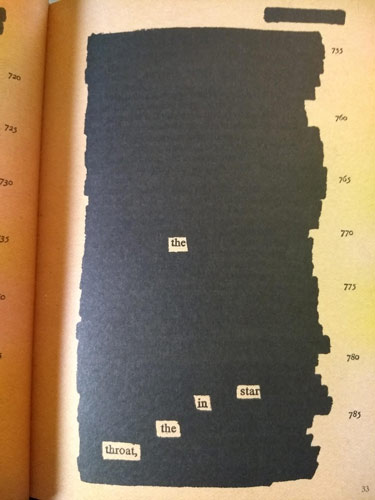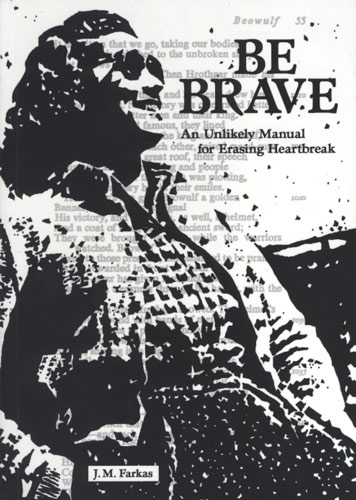Be Brave
Be Brave: An Unlikely Manual for Erasing Heartbreak is tremendous. I came upon this volume by sheer dumb luck—through a professional discussion board on which I was posting my first ever reply after lurking for years—to J.M. Farkas, who had written her first ever post to the group “looking to connect with teachers teaching Beowulf” who were open to unexpected ways of approaching the text. Yes, please! But, as I learned, Be Brave isn’t just about Beowulf. In fact, it’s hardly about Beowulf per say. It is a complex, layered work, starting with its origin.
Be Brave: An Unlikely Manual for Erasing Heartbreak is tremendous. I came upon this volume by sheer dumb luck—through a professional discussion board on which I was posting my first ever reply after lurking for years—to J.M. Farkas, who had written her first ever post to the group “looking to connect with teachers teaching Beowulf” who were open to unexpected ways of approaching the text. Yes, please! But, as I learned, Be Brave isn’t just about Beowulf. In fact, it’s hardly about Beowulf per say. It is a complex, layered work, starting with its origin.
Farkas opens the book with: “Sometimes you think you’re writing to one person, but it turns out you’re writing to someone else.” The book—an erasure poem using Beowulf as the source text—was motivated by a re/break-up, “Because I had to somehow find a way to unsplit my own obliterated heart.” She goes on to envision the recipients of this text: her former teacher, her own former students (having been a high school English teacher), and above all, her grandmother. In the dedication at the close of the book she confides: “The truth is, I never intended for this book to be anything more than a personal project. And for many, many months after I finished the blackout, it sat in a dark drawer.” It was the passing of her grandmother that drew those pages out and into a publication, and for which now Farkas envisions the audience as “explicitly female”:
It never sat well with me that the canon and the classic high school English syllabus are so expressly male. So I decided that I wanted to continue to pursue erasure with more purpose. I wanted to spin a feminist-revisionist twist on the classics. I wanted to create books for females about females by a female to empower females. Be Brave is just the beginning.
Farkas left teaching to pursue her MFA, and in doing so, was “wooed by the rebelliousness of erasure.” She had taught using Austin Kleon’s Newspaper Blackout, but it was Jen Bervin’s Nets that became the greatest influence with her “erasure of an entire book.” Farkas also mentions being encouraged by Mary Ruefle (A Little White Shadow), who allowed her to submit erasure projects instead of the traditional essays for coursework. “The act of blacking out text sparks one of the central questions I have for myself as a writer: what can I get away with?”
 Farkas explains her approach, discussing the “playfulness” of erasure’s “mysterious process” as well as the nuts and bolts: having to procure multiple copies of Burton Raffel’s 1963 translation in order to have a final, readable copy. She writes that the process is “also about faith. A trust that everything you need, everything you want, the exact word you are search for, that you’re hoping might appear next, is often waiting for you on the very next page. Your job is to be still. To stay there until you find it.”
Farkas explains her approach, discussing the “playfulness” of erasure’s “mysterious process” as well as the nuts and bolts: having to procure multiple copies of Burton Raffel’s 1963 translation in order to have a final, readable copy. She writes that the process is “also about faith. A trust that everything you need, everything you want, the exact word you are search for, that you’re hoping might appear next, is often waiting for you on the very next page. Your job is to be still. To stay there until you find it.”
For the reader, the experience is of unfolding, of flipping each page to sift across the blackness to discover the one or two or three words that have been chosen to connect to those before and after and to follow the feelings as they build and swell with each turn. Like Farkas’s own discovery, this was my first time reading erasure text as a book, and I was surprised by the playfulness, yet seriousness, the exhilaration and excitement of coursing through the pages with only one word or two words (or none) left in the clearing. I found myself wanting to speed up to get to the next word, but at the same time to slow down to let it sink in.
The book is only 99 pages of source text with a total of 427 words (counting “high-arching” as one) and can—and should—be read in one sitting, then reread more slowly, then reread out loud, then reread by listening to someone else read it. Every reading brings the text a new life, a new meaning, a new layer of emotion and intellect and perspective. There is nothing “simple” about this work, which follows a story of breakup and heartbreak, beginning with:
Be brave
refuse his shining
Be fierce and swelled and resolved and young and over it
To begin, recall he is slime
sprawled in her knowing bed delighted by Her empty hands.
follow his bent. heartSimmer bitter and unending, Be the sea Be Ready be sad,
like a rock
be Exactly who you are,
Then move on.
Like a song
Be alone.
Farkas then challenges the brokenhearted, the downtrodden, the bereft and the left behind to get over it, to find new ways to be, with the repetition of “be” commands throughout: be a poet, be eager and angry, be bewitched, be wounded with delight, be the queen and the hero, be alive now, be golden . . . . With each new iteration of be, I honestly felt myself swelling with energy, with feist, with a desire to take on the charge of living this life! The words on the page rise and fall like waves on an ocean, culminating in the final three “be” statements that compel the reader to wrap herself in her own strength and love. And be.
That Farkas has used Beowulf as her source text lends itself to the magnitude of this endeavor. Taking one of the cornerstone “masculine” texts of the canon and transforming it into a woman’s emotional healing journey adds a lush complexity to this genre. She has, in a sense, utilized the erasure process to draw out the feminine, or rather, feminist, and in doing so has created a completely unique and independent hero archetype. Having taught Beowulf in college for decades, I have never once felt as connected to the character as I do now. I can definitely see using Be Brave as a text in my course, having students create their own erasure text from some pages of the epic, empowering them to draw out their own hero’s vision.
The book concludes with a dedication to Farkas’s grandmother, and unlike other dedications, these few pages are both a stand-alone poetic biography and essential to the holistic concept of the text. There is an incredible risk and strength in Farkas appropriating this male text for a female-focused audience, but it is the same risk and strength she conveys having witnessed her grandmother live every day. Perhaps that many of us witness in our own matriarchal lineage, perhaps in ourselves. The book concludes on this literary portrait, drawing the reader back around to the cover image—a portrait of the grandmother in her youth and the words “Be Brave.” If every woman who reads this book doesn’t both cry at having been struck so precisely at her core of connectedness and feel like she can take on the world all by herself, then she may not yet be ready to unleash the power this kind of writing holds.
This is a beautiful book. It is a warrior’s journey and a gift. A work that, at any low point in a woman’s life, she should take as her tonic, and for women enjoying a peak in life, to use as their battle cry to enter daily challenges. A rallying cry and a comfort all in one. If this is just the first in a series by Farkas, then we all have much to look forward to.





